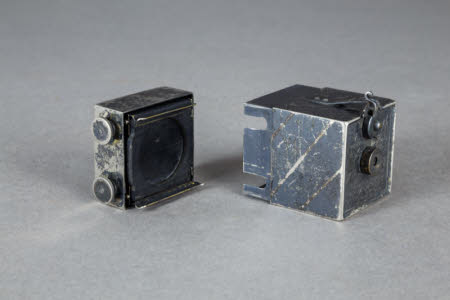A Kombi miniature box camera manufactured by Kemper
Category
Photographic technology
Date
1892
Materials
Brass?, Glass
Place of origin
Chicago
Order this imageCollection
Fox Talbot Museum, Wiltshire
NT 1524631
Summary
A Kombi miniature box camera manufactured by Kemper and invented by William V. Esmond of Chicago, c.1892. Described as the first miniature, roll film camera, it was made to take 25 exposures, 11/8 inch square (or round) on roll-film manufactured by Kodak solely for use in a non-Kodak camera. The camera doubled as a transparency viewer (a graphoscope) for looking at developed film. The camera is a two-part metal box with decorative oxidized silver finish (now scratched and worn). The back formed an exchangeable roll film magazine, which, with the exposed film, had to be sent to the Kodak factory for film development and reloading. The front part of the camera houses the lens of the camera/eyepiece of the graphoscope, and a basic lever shutter. This particular Kombi lacks the copper clasp that joins the front and back parts of the box camera together. Its film rollers, platen and round mat remain, but there is no accessory roll-holder back, or external box case. Markings: on front is the elaborately engraved name, 'The Kombi', and decoration. Above the lens is marked: 'A Combined Camera and Graphoscope'. On the back, within a decorative raised metal circle, are the patent dates.
Provenance
Part of The Fenton Collection. A gift from British Film Institute in 2017. From 1986-1999, part of BFI collection for the Museum of the Moving Image. BFI purchased collection in 1986 from James Fenton's Museum of Photography, Port Erin, Isle of Man 1976-1986.

